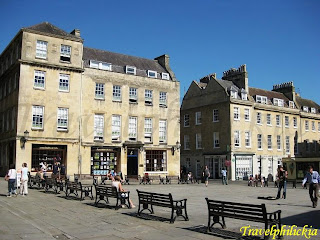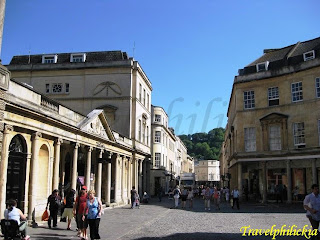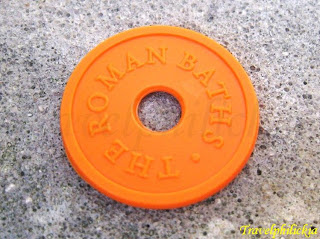Booked the day tour from Premium Tours almost 3 weeks prior to our arrival in London via the internet for £ 69 per person. Reason is we don't want to be disappointed and wanted to get out of London city on our last available full-day. This tour covered 3 sights, namely Windsor Castle, Stonehenge and Bath. The duration of the tour took about 12-hours.
After breakfast, my colleague and I walked a few streets away to Hilton hotel to be picked up by the complementary shuttle bus to Victoria Coach station (left photo below). The coach bus departed at 0830 hours sharp and took about an hour to reach the first sight: Windsor Castle. Upon reaching the Admission Centre of the Castle, the tour guide handed us an admission ticket each (right photo below).


Windsor Castle
After some security screening, the tour group was brought to the Audio Tour Collection / Return booth (left photo below) to collect our Audio Guide (right photo below). This audio guide was used inside the Queen Mary's Dolls' House and the State Apartment.


Windsor Castle is one of the oldest royal residences still in use today. For over 900 years it has been a potent symbol of the monarchy. Built by William the Conqueror within what was a royal hunting forest after the Norman Conquest in 1066, Windsor Castle has been successively enlarged, adapted and rebuilt by monarchs from Henry II to Queen Elizabeth II. The fire in 1992 gave the Castle a new legacy; including the superb new interior to the historic St. George's Hall, and most recently the Jubilee Garden has been added to celebrate the Golden Jubilee of Her Majesty The Queen. The castle remains an important venue for ceremonial visits from Heads of State of other countries.
Our tour guide led us through the various structures / buildings within the castle, such as the King Henry VIII Gate (left photo below) and Victoria Monument (right photo below) of the lower ward. Followed by the St George's Gate (bottom left photo) and Engine Court (bottom right photo) in the middle ward of the castle.




The keep, better known as Round Tower (left photo below), is easily recognizable among the many structures of the middle ward within the castle. If a Sovereign's Standard flag is seen flying from this Round Tower, this indicates that the Queen is in residence. From the photo below, the Queen was not around during our visit. The tour group was next led to the Upper ward (right photo below) to visit the Castle's main exhibition: Queen Mary's Dolls' House and the State Apartment. As no photography is allowed inside the Castle, therefore I can't post any pictures here to illustrate its exquisite Gothic interiors.


According to our guide, The Queen and other members of the Royal Family continue to spend most of their private weekends at an exclusive part of Windsor Castle and this area (photos below) is definitely out-of bounds to visitors.


Changing the Guard (photos below) takes place at 1100 hours daily, when weather permitting, from Monday to Saturday from April to end of July, or on alternative days from August to end of March. Do note that there is no Changing the Guard on Sundays.


St. George's Chapel
St. George's Chapel (photos below) is the place of worship at Windsor Castle. It is both a royal peculiar and the chapel of the Order of the Garter. The chapel is located in the Lower Ward of the castle, which is one of the principal residences of Queen Elizabeth II.
The chapel has been the site of many royal weddings and funerals.


Windsor Royal Shopping
Windsor Royal Shopping (photos below) is located at Windsor & Eton Central station. This train station is one of two terminal stations serving the town of Windsor in Berkshire. A tourist oriented shopping centre; the mall has over 40 shops with an array of continental style restaurants and bars, and an art and craft market which open daily.


The coach bus brought us to a country pub for lunch. Price of lunch was not included in the tour package and an additional cost of £ 11 was required for Fish and Chip. However the tour agent recently decided to include lunch as part of the tour package; as the saying 'there's no free lunch in this world', the cost of the tour also increased.
Stonehenge
The tour group was then brought to the second sight: Stonehenge. Like the Windsor Castle tour, hand-held audio guide was also distributed to each visitor.
Probably the most famous prehistoric monument in the world, Stonehenge stands in the middle of the vast empty tract of Salisbury plain located in the Wiltshire county (photos below).


Its origins can date back to nearly 5,000 years, and has been home to pagan religion and spiritual worship. The stones are aligned to the mid-summer sunrise and mid-winter sunset, but its exact purpose remains a mystery. More mysteries still remain unsolved such as who carved and moved these 40-tons stone to the present site.
 |
Stonehenge, together with its surroundings, was listed as World Heritage Sites by UNESCO in 1986. |




Besides the henge, there is one famous stone known as the 'Heel Stone' (left photo below) that stands near the main entrance next to A344 road. It is about 7.6-meters tall from the ground, weighs almost 35-tons and leans southwest nearly 27 degrees from the vertical. Like other stones, its exact purpose remains unsolved. One interesting observation was sheeps can be found grazing and resting (right photo below) at the plains close to the Stonehenge.


City of Bath
Bath is a city of Somerset County located 156-km west of London. The city was first established as a spa for the Romans. The Romans built baths and a temple on the surrounding hills of Bath in the valley of the River Avon around the hot springs. Much later, Bath (left photo below) became a popular as a spa town during the Georgian era.
 |
The surge in tourism is mainly attributed to the city being listed as World Heritage Site by UNESCO in 1987. |


The city has become one of the most visited cities in England as many buildings are built in Georgian style (photos below).


Bath Abbey
Also known as the Abbey Church of Saint Peter and Saint Paul, the Bath Abbey (left photo below) is located in the centre of the city. The building contains monuments to several notable people, and has two organs and a peal of ten bells. One interesting feature of this church is 'Angels' are seen climbing the Jacob's Ladder (right photo below) on the west front of Bath Abbey.


We were allowed to self-explore the city for about 45-mins before the tour group met up for our last visit inside the Roman Bath.
The Roman Baths
Gathered outside the entrance of the Roman Baths (left photo below), each of us was given an orange chip (right photo below) as an admission token into the museum.


The Roman Baths complex is a site of well preserved Roman site for public bathing. The original site was used by the Roman during 1st century, while the current buildings were built in 18th to 19th century. The actual bath is below the modern street level (left photo below), while carvings of many Roman Emperors and Governors of Roman Britain (right photo below) are found on the terrace overlooking the bath.


The museum houses many artefacts from the Roman period, including objects which were thrown into the Sacred Spring (photos below).




Miniature models (photos below) are used to illustrate the former structure and various functions of the bath complex.


Surprisingly water still flows through the Roman Baths from the Sacred Spring Overflow (photos below). However the water that flows through the Roman Baths is considered unsafe for bathing; an incident occurred in 1979 proven that the water is contaminated with infectious diseases.


The Great Bath (photos below) is still fed with hot water from the hot spring and often steam can be seen rising from these baths. Hot water at a temperature of 46°C rises at the rate of 1,170,000 litres every day from a geological fault.


Besides the thermal bath, the circular bath known as frigidarium (left photo below) was a cold pool used for swimming or a dip after soaking in a hot bath. A caldarium was another feature in Roman Baths where it was a room with hot water plunge. The floor has been removed in the museum (right photo below) to reveal the empty spaces where the hot air flowed through to heat up the floor.


After boarded the coach bus, and while the bus just began to depart, I took the last set of photos of the terraced houses of this historical city (photos below). This day trip ended by departing from Bath and we were then droved back to London city.


Dinner at Malaysia Kopi Tiam
We had dinner at this Malaysia Kopi Tiam (left photo below) for the last time as we really missed Singaporean food badly while staying in Switzerland. We shared a plate of Fried Chicken Wings at £ 3 (right photo below), while I ordered a mushroom noodles at £ 6 (bottom left photo) and an ice BoBo ChaCha at £ 2.80 (bottom right photo) for myself. Taste was good and authentic as expected.




Day Five
Woke up early in the morning, we took the public bus no. 148 to Victoria Station and followed by Gatwick Express to the airport.
As we didn't take the complementary breakfast at the hotel, soon after custom checks at Gatwick Airport, we then had our breakfast at an eatery called 'EAT' inside the transit area. This was where I ordered a sausage muffin at £ 2.05 and a cup of mocha at £ 2.05 with £ 0.35 of organic whipping cream (left photo below). Must comment that this meal was fulfilling which lasted me till I reached Geneva Airport at 1100 hours. After which I then bought a sandwich at CHF 2 and an ice peach tea at CHF 1 (right photo below) from a local supermarket 'Migros' at Gevena train station.


Had a quick wash-up at my apartment in Neuchâtel before heading back to the office for lunch and worked for the rest of the day. With this, it ended my tiring but fulfilling 5-days trip in London.
 Posts RSS
Posts RSS


